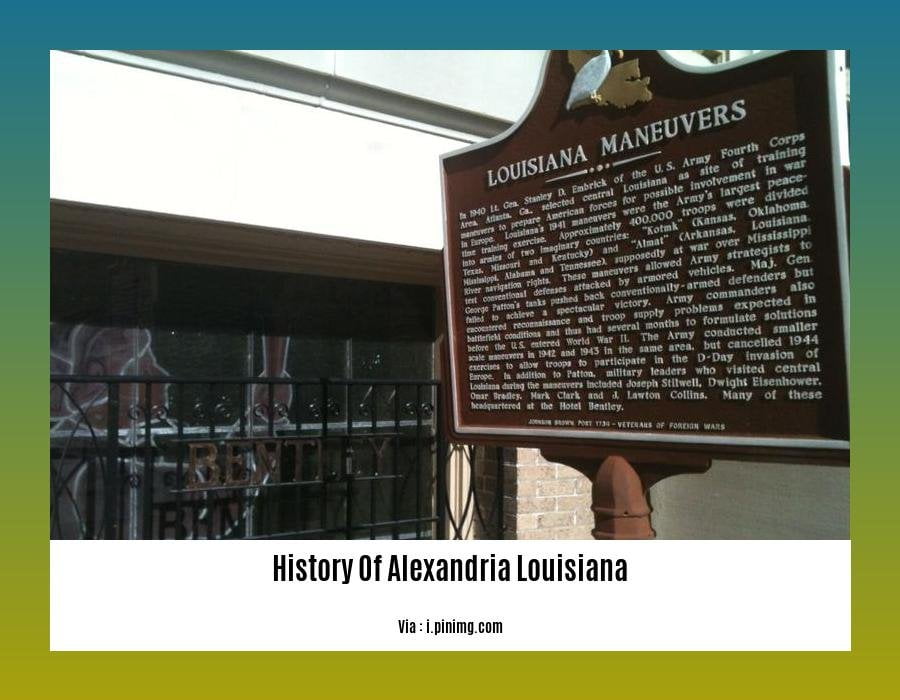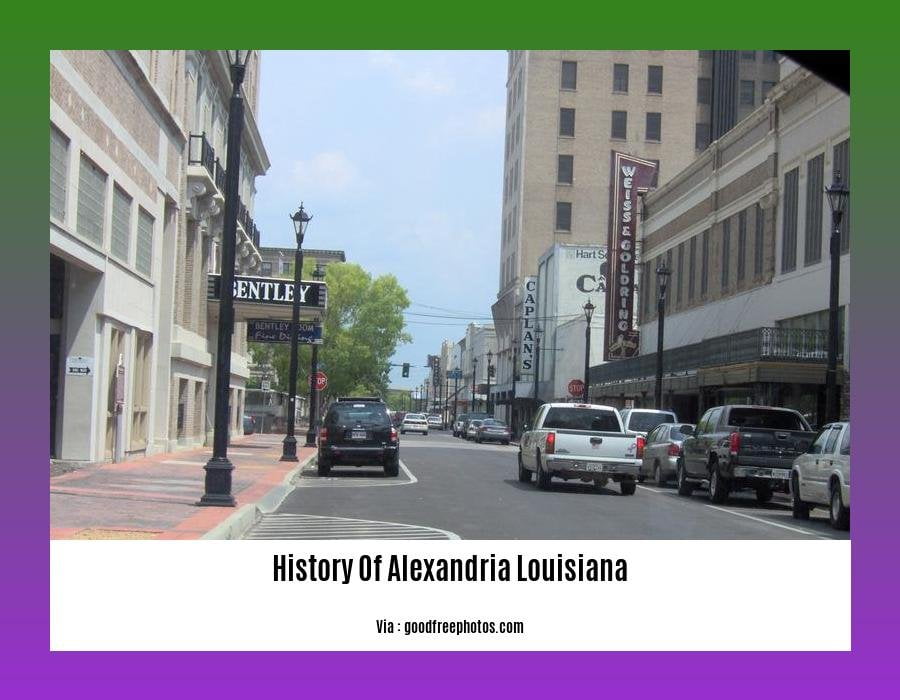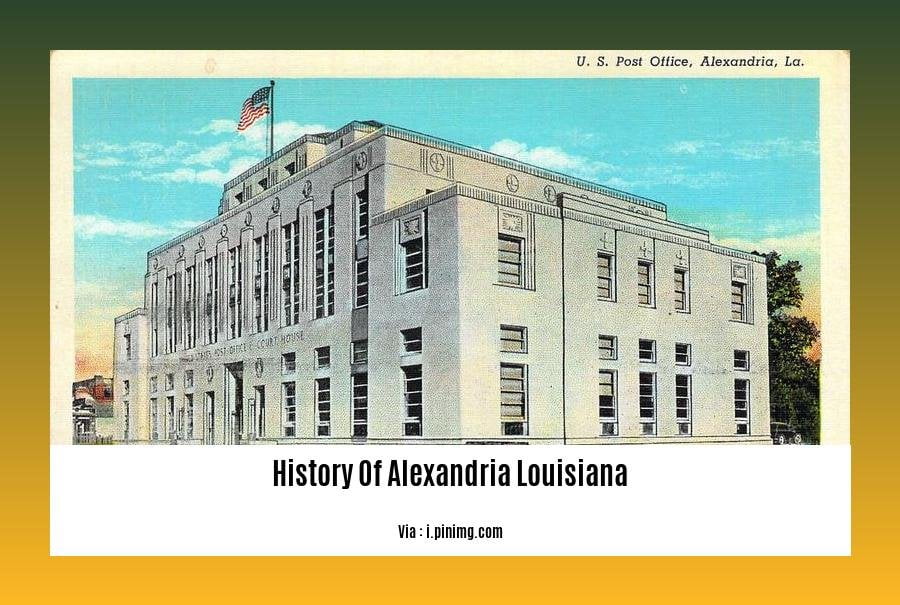Alexandria Louisiana, a city steeped in the rich tapestry of time, invites us to unravel its fascinating history. From its humble beginnings as a trading post to its pivotal role in the Civil War and beyond, this captivating narrative traces the transformation of Alexandria, leaving an indelible mark on the annals of Louisiana’s past.
Key Takeaways:
- Alexandria is Louisiana’s ninth largest city and the seat of Rapides Parish.
- It’s located in the central part of the state on the southern bank of the Red River.
- As of 2020, Alexandria’s population was 45,275.
- The city houses the Alexandria Museum of Art and is renowned for its performing arts, with venues like the Coughlin-Saunders Center.
- Alexandria is surrounded by the Louisiana Longleaf Pine forests.
History of Alexandria Louisiana

Let’s dive into the tapestry of time and explore the History of Alexandria Louisiana, a city with roots as deep as the Red River that flows alongside it.
In the heart of Louisiana, where the Red River meanders gracefully, lies Alexandria, a city steeped in rich history. Founded in 1805 by Rapides Parish, Alexandria has blossomed into the ninth-largest city in the state. Its strategic location at the geographic center of Louisiana has made it a hub for commerce and culture throughout its existence.
Alexandria’s past is intertwined with the vibrant tapestry of Louisiana’s history. From its humble beginnings as a trading post to its role as a vital port during the Civil War, the city has witnessed countless events that shaped the destiny of the state. Explore the historic buildings that line its streets, each whispering tales of a bygone era.
Today, Alexandria is a vibrant cultural center. Its thriving arts scene, anchored by the Alexandria Museum of Art and the Coughlin-Saunders Performing Arts Center, brings life and color to the city. Immerse yourself in the rhythm of live performances, admire captivating art exhibitions, and soak up the creative energy that permeates the atmosphere.
Step into the lush Louisiana Longleaf Pine forests that embrace Alexandria. Majestic pine trees soar towards the heavens, interspersed with a symphony of hardwoods. These verdant landscapes invite you to connect with nature and embrace the tranquility that surrounds the city.
As you journey through the History of Alexandria Louisiana, you’ll discover a city that has seamlessly woven its past into its present. Embrace its charm, delve into its stories, and witness the enduring spirit that continues to shape its destiny.
To unravel the captivating history of this ancient city in Egypt, explore the insightful history of Alexandria article.
Delve into the rich tapestry of Virginia’s past through the fascinating history of Alexandria, VA.
Embark on a journey through the annals of this Egyptian metropolis in the comprehensive history of Alexandria, Egypt.
Uncover the intriguing story behind this Minnesota town in the history of Alexandria, MN.
Discover the captivating narrative of this Indiana city in the history of Alexandria, Indiana.
Explore the captivating history of this Kentucky town in the history of Alexandria, KY.
Dive into the vibrant history of this New York town in the history of Alexandria Bay, NY.
Uncover the rich heritage of Virginia’s Old Town in the history of Alexandria, VA Old Town.
Journey through the annals of this renowned institution in the history of the Alexandria Library.
Embark on a captivating exploration of this Australian city in the history of Alexandria, Sydney.
American Civil War and Reconstruction

Louisiana played a pivotal role in the American Civil War and Reconstruction. Here’s a concise overview:
Louisiana’s Significance
- Dominant population center in the southwest Confederate States of America.
- Controlled the wealthy New Orleans trade center.
- Contributed significant French Creole and Cajun populations to the Confederacy.
- 47% enslaved population in 1860, with a large free black population.
Secession and War
- Louisiana declared secession from the Union on January 26, 1861.
- Served as a major battleground and supply center for the Confederacy.
- New Orleans captured by Union forces in 1862.
Reconstruction Era
- Louisiana underwent significant political, social, and economic changes after the war.
- Federal troops enforced Reconstruction policies to protect freed slaves.
- White supremacy and racism persisted, leading to violence and unrest.
- Louisiana eventually regained self-governance in 1877.
Key Takeaways:
- Louisiana’s strategic location and diverse population played a crucial role in the American Civil War and Reconstruction.
- The war had a profound impact on the state’s economy, society, and political landscape.
- Reconstruction was a challenging period marked by both progress and setbacks.
Sources:
- Louisiana in the American Civil War
- Louisiana in the Confederacy
Growth and Development in the 20th Century
Let’s delve into the remarkable Growth and Development in the 20th Century that shaped Alexandria, Louisiana, a vibrant city nestled in the heart of the state.
Key Takeaways:
- Alexandria emerged as a significant commercial and cultural hub in the early 1900s due to its strategic location on the Red River.
- The establishment of colleges and universities, including Louisiana State University at Alexandria, fostered intellectual growth and educational opportunities.
- The city’s cultural scene flourished with the founding of the Alexandria Museum of Art, showcasing local and regional art.
- Alexandria became a hub for businesses, industries, and agriculture, leading to economic prosperity and population growth.
- The city embraced technological advancements and infrastructure development, enhancing its connectivity and accessibility.
As we reflect on Alexandria’s Growth and Development in the 20th Century, we recognize the remarkable transformation that shaped its present and serves as a foundation for its future aspirations.
Sources:
Modern Alexandria: Challenges and Opportunities
Alexandria, Louisiana, is a city with a rich history and a promising future. However, like many other cities across the country, Modern Alexandria faces its own set of unique challenges and opportunities, which require careful consideration and innovative problem-solving. This section will delve into some of these challenges and opportunities, providing insights and perspectives to help guide the city’s path forward while preserving its legacy.
Challenges
Preserving Architectural Heritage
Alexandria is renowned for its stunning architecture, which reflects its diverse cultural influences. However, preserving these historic treasures poses significant challenges. Budget constraints, lack of awareness, and competing development priorities often threaten the preservation of these invaluable landmarks.
Unplanned Urban Development
Alexandria is experiencing rapid growth. Rapid and unplanned urban development can lead to environmental degradation, traffic congestion, and a loss of the city’s unique character. Balancing growth with responsible land-use planning is crucial for maintaining a sustainable and livable city.
Economic Diversification
Alexandria’s economy has traditionally relied heavily on industries such as oil and gas. However, with the fluctuating nature of these industries, economic diversification becomes essential. Fostering innovation, supporting entrepreneurship, and attracting new businesses from diverse sectors are key to creating a resilient economy.
Opportunities
Cultural Tourism
Alexandria’s rich history and diverse culture offer immense opportunities for cultural tourism. By promoting its historic sites, art scene, and unique local experiences, the city can attract visitors, boost the local economy, and showcase its rich heritage.
Education and Workforce Development
Alexandria is home to several colleges and universities. Leveraging these institutions to develop a skilled workforce and attract top talent can enhance the city’s economic competitiveness and provide opportunities for residents to advance their careers.
Smart City Initiatives
By embracing smart technologies and infrastructure, Alexandria can improve efficiency, sustainability, and quality of life for its citizens. From smart energy management to digital connectivity, smart city initiatives can address challenges and enhance the overall livability of the city.
Key Takeaways:
- Preserving Alexandria’s architectural heritage requires creative solutions and a commitment to balancing growth with conservation.
- Unplanned urban development can be addressed through thoughtful land-use planning and sustainable growth strategies.
- Economic diversification is essential for creating a resilient and prosperous Modern Alexandria.
- Cultural tourism can leverage the city’s rich history and diverse culture to boost the economy and attract visitors.
- Education and workforce development are key to ensuring a skilled workforce and advancing residents’ careers.
- Smart city initiatives can enhance efficiency, sustainability, and overall livability in Modern Alexandria.
Relevant Sources:
- Alexandria Louisiana History
- TakeLessons: Online History Tutors
FAQ
Q1: When was Alexandria, Louisiana founded?
A1: Alexandria, Louisiana was founded in 1805 by Alexander Fulton.
Q2: What is the significance of the Red River to Alexandria?
A2: Alexandria is located on the south bank of the Red River, which was once a major transportation route and played a vital role in the city’s growth and development.
Q3: What are some of the architectural landmarks in Alexandria?
A3: Alexandria has a number of historic buildings and architectural landmarks, including the Alexandria Museum of Art, which occupies a historic building on the banks of the Red River.
Q4: What is the current population of Alexandria?
A4: As of the 2020 census, Alexandria had a population of 45,275.
Q5: What are some of the challenges facing Alexandria?
A5: Today, Alexandria faces challenges related to preserving its architectural heritage and addressing unplanned urban development.
- Star Ring Trends: Etsy vs Amazon - March 28, 2025
- Boost Pollinator Habitats: Baby Blue Eyes Sustainable Farming Guide - March 28, 2025
- Protect Big Black Bears: Effective Conservation Strategies - March 28, 2025




![- [History Of Alexandria Bay Ny]: Unveiling the Enchanting Past of a Thousand Islands Gem History-Of-Alexandria-Bay-Ny_2](https://www.lolaapp.com/wp-content/uploads/2024/02/History-Of-Alexandria-Bay-Ny_2-150x150.jpg)











